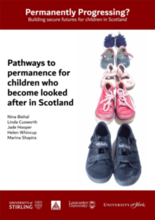The Permanently Progressing? study investigated decision making, permanence, progress, outcomes and belonging for a large cohort (1,836 children) of all children in Scotland who became looked after in 2012-13, when they were aged five or under. Using national data from the Children Looked After Statistics (CLAS) we analysed children’s progress over four years (2012-2016). The study is the first to compare pathways and outcomes for such a large cohort of young children in Scotland. It is designed to be the first phase in a longitudinal study tracking children’s progress into adolescence and beyond.
Phase One of the study has five strands, with a report and summary for each strand. Each of the summary documents begins with a list of key messages and concludes with implications for policy and practice. Sitting alongside the five summaries, is an additional information sheet for children (including an audio version) explaining the purpose and outcomes of the study.
This report presents the findings from strand one of the study, Pathways to Permanence for children who become looked after in Scotland. This strand analysed data from the Children Looked After Statistics (CLAS) provided to the Scottish Government by all 32 local authorities on the total cohort of children who became looked after during the year 1 August 2012 - 31 July 2013 when they were aged five and under (n=1,836). Of the 1,836 children, 481 children were looked after at home and 1,355 children were looked after away from home. This strand of the study investigated children’s pathways into and through the looked after system over four years from 2012-16, including the route and timescales to permanence.


